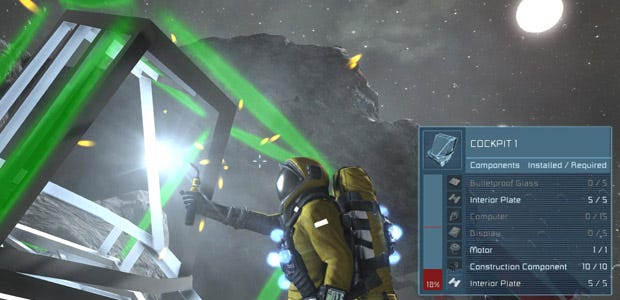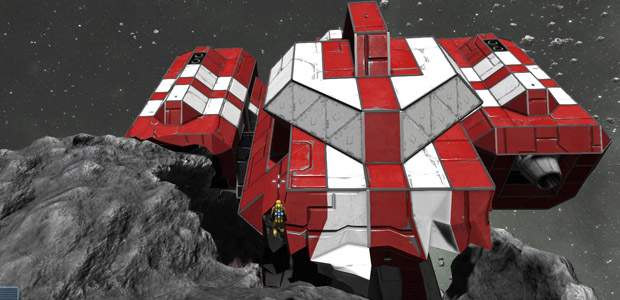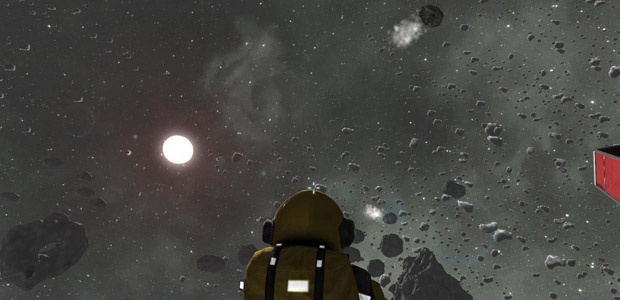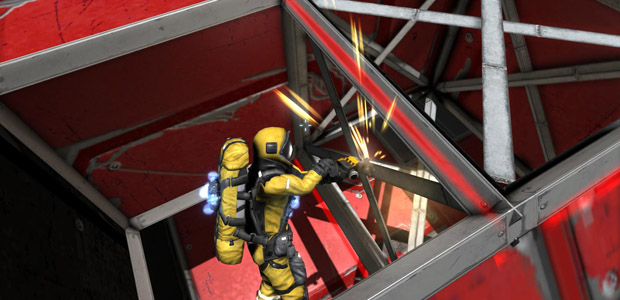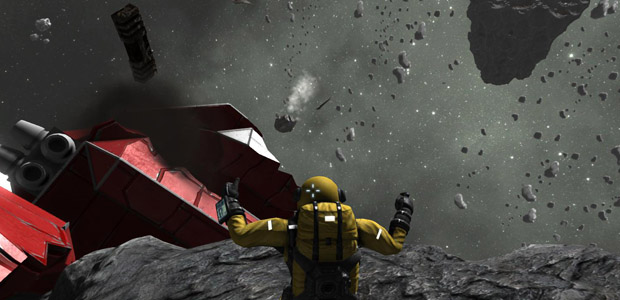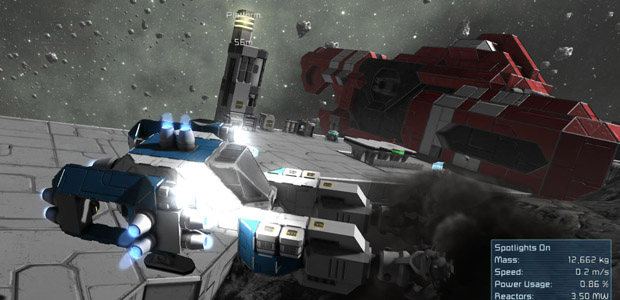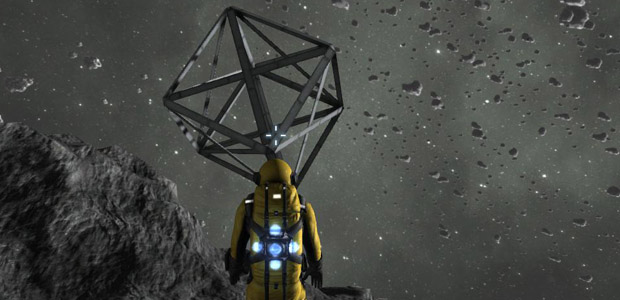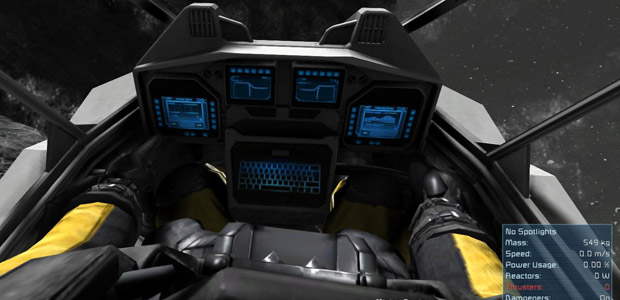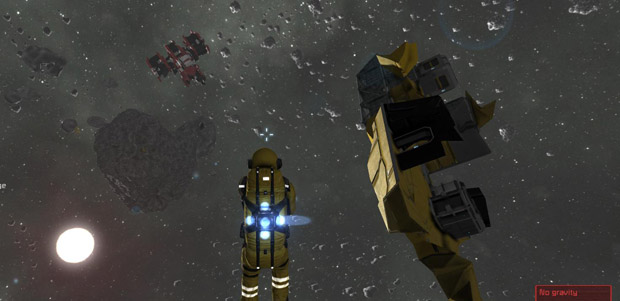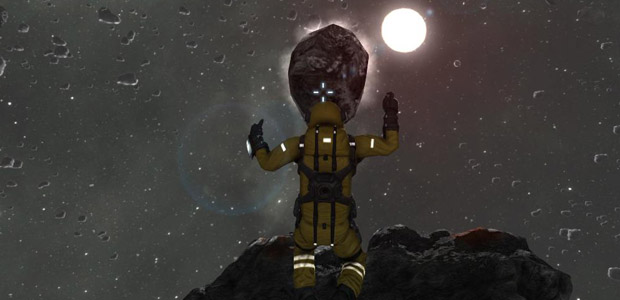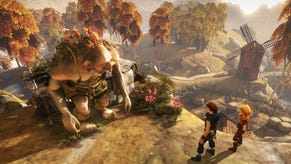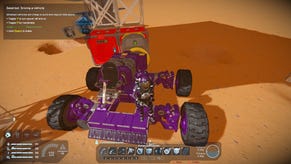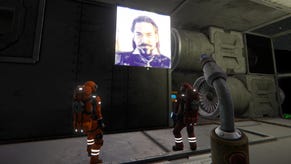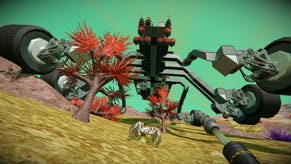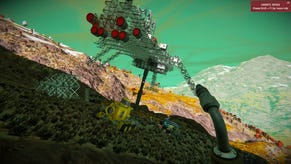The Lighthouse Customer: Space Engineers (Survival Mode)
Gravity Boned
Each Monday, Chris Livingston visits an early access game and reports back with stories about whatever he finds inside. This week, space-based gathering, crafting, and dying in Space Engineers' new survival mode.
There's a large red and white spaceship, its front end crumpled after what must have been a spectacular nosedive. There's a tiny yellow space engineer inspecting the wreck, armed with only a handful of tools. There's the inky blackness of outer space, the comforting glow of a distant sun, and an asteroid field of stationary rocks, chock-full of ore and minerals to mine. As the astronaut floats there, enchanted by the view, he notices a few of the asteroids -- quite a few, in fact -- have given up waiting for him to visit them and taken a more proactive stance. They're delivering themselves to him. Well, at him, anyway. In an awful hurry.
Until recently, the only way to play Space Engineers was in creative mode, which gave early-access astronauts a gravity-free sandbox of unlimited materials with which to assemble (and destroy) their space creations. In the newly implemented survival mode you'll need to mine for materials and set up production lines to fabricate parts. And, when building, you're not just building piece-by-piece but building each piece piece-by-piece.
Astronauts also need to closely manage their constantly depleting energy levels, which means that even though you can't hear it in space, the clock is always ticking. In survival mode, using your jetpack drains energy. Operating tools drains energy. Having any system of a ship turned on drains energy, even if you're not using it.
That last one is not a problem for me at the moment: I have no systems to leave on, or even turn on. I have nothing but a few tools, and I'm doing nothing but simply looking at my crashed spaceship, the asteroid it crashed into, and the lovely view of outer space. Oh, and those other asteroids hurtling my way. Right!
Clearly, there's no time to waste. My goal is to create a space platform, cover it with mineral-baking refineries and assemblers, build myself a new spaceship, and blast off this rock. I begin carving up the wrecked ship with my grinder, collecting the steel as it peels from the hull. My inventory can hold only 400 kg worth of resources at a time, and as it turns out, that's not very much at all. That which I cannot carry slowly floats away into space, a troubling sight for someone accustomed to stuffing mountains of tree trunks and stone blocks into his pants in other, more forgiving crafting games. And, I'm not the only one hard at work deconstructing the ship: the asteroids that have been whizzing by often hit and bash free huge sections of the wreckage, sending massive chunks of untapped resources pinwheeling away into space.
I should point out that things needn't be quite this grim. There are a number of options when setting up your survival session. Inventory size, for example, can be up to ten times bigger than the "realistic" one I'm using. The frequency of incoming asteroids can be turned down, or they can be switched off entirely. There are more forgiving maps to choose from as well, including one with an existing space station, fully-powered generators, cargo containers full of goodies, refiners, assemblers, health stations, and working ships to get you off to a running (well, hovering) start.
Building in survival mode works a bit differently than in creative mode. Gone are the days of simply selecting a block and placing it, fully formed, into space. In survival, it's only the mere framework of the object that appears. It then needs to be welded to completion using the resources in your inventory, meaning putting together even a single basic block takes some time. Nicely, though, you don't need to be in possession of all the resources to begin building: your creation will wait, skeletal and unfinished, until you return and complete it. This also comes in handy in multiplayer survival games, where one player can plop down the skeleton of a structure and others can fill it in.
This isn't multiplayer, however. I am alone in my endeavors, and the barrage of asteroids continues, smashing not only the shipwreck but the space platform I've been working to assemble for a good half-hour. It becomes clear I'm not going to be able to build a big platform with a full production and fabrication line. My revised plan is this: build a small escape craft, pilot it off the asteroid, land somewhere else, and call it a win. The minimum I'll need: a small frame, a cockpit, a reactor, a gyroscope, six thrusters, and some landing gear.
Then, suddenly, I'm dead, the victim of yet another asteroid impact. I respawn in a small ship, a tiny yellow vessel that quickly carries me back to my asteroid and promptly crashes right next to the red ship.
On the one hand, I'm still stranded on the exact same rock I was when I began. On the other, now there are two crashed ships to salvage. At least the newer one has a working reactor, a medical bay to recharge my suit, a storage container so I can save up resources, and even a refinery. I get back to work, managing to construct some landing gear and the basic frame of my escape shuttle. It takes several trips, regularly rocketing back to the wreckage to harvest, recharge, and deposit or withdraw materials from the cargo bay, but I finally manage to construct and complete a cockpit.
Sure, there's only single thruster and no gyroscope. But dammit, my little escape pod is coming along and I can actually sit in the cockpit, look at the display screens, and make blast-off sounds in my head.
The good vibes don't last long. I climb out of my cockpit and notice, with no small degree of horror, that the rescue ship wreckage has become so battered with meteors that it has broken away from the asteroid and is floating away into space. Noooo! My health station is in there! A working reactor is in there! My cargo container with all my precious cruft in it! It's floating away!
I give chase but it's spinning so wildly I can't manage to enter it to retrieve my cargo, recharge my suit, or even cut a last few desperate chunks off it. Even worse, as I turn back, I see the main spaceship wreck has also detached from the asteroid and it, too, has begun floating away into space.
Okay, time to revise my revised plan. I'm just going to get in my tiny single-thruster ship and blast the hell off. I won't be able to steer or control it, but with a little luck I'll be able to fly in a straight line and collide with some other stationary rock out there, and if so, I'll consider that a successful "escape" from this punishing survival mode. I jet back to my shuttle, maneuver my way to the cockpit, and then notice that something is suddenly blotting out the sun.
Somehow, the massive hurtling rock misses me. Unfortunately, it completely kerplodes my tiny space station, leaving just a single, mangled cube intact. The entirety of my escape pod, what little of it there was, is completely gone.
Oh, the hell with this. I'm starting a new game with a few different options ticked. This time I'm going to play with no asteroid strikes, a pre-built station, and a few other... perks.
Now, this is the kind of survival I can survive.
